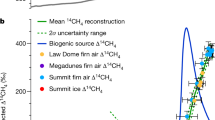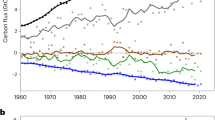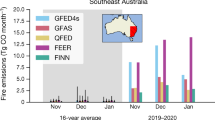Abstract
THE dilution of the atmospheric 14CO2 concentration by large amounts of fossil-fuel derived CO2 which do not contain any 14C is commonly called the Suess effect. Its magnitude can be calculated with the same geochemical models as the global carbon cycle that also predict the future rise of atmospheric CO2 to be caused by the combustion of fossil fuels. Validation of a CO2 predictive model with the Suess effect 14C data is important because these two phenomena have a common cause, and therefore register model responses at roughly the same frequencies. Measurements of the Suess effect yield values between −15‰, and −25‰ in Δ 14C (in 1950)1, while different model predictions also cover about this range2,3. The requirement that a model correctly reproduces the Suess effect becomes a strong constraint when the accuracy of the measurement is improved to better than 2‰. 14C measurements in tree rings to an accuracy of 1.2‰ are reported here. The results indicate that the natural fluctuations of atmospheric 14C as yet preclude determination of the Suess effect to the accuracy required by the models.
This is a preview of subscription content, access via your institution
Access options
Subscribe to this journal
Receive 51 print issues and online access
$199.00 per year
only $3.90 per issue
Buy this article
- Purchase on Springer Link
- Instant access to full article PDF
Prices may be subject to local taxes which are calculated during checkout
Similar content being viewed by others
References
Lerman, J. C., Mook, W. G. & Vogel, J. C. in Radiocarbon variations and absolute chronology (ed. Olsson, I. U.) 275–301 (Wiley, New York, 1970).
Bacastow, R. & Keeling, C. D. in Carbon and the biosphere (eds Woodwell, G. M. & Pecan, E. V.) 86–135 (US Atomic Energy Commission Conference 720510, 1973).
Oeschger, H., Siegenthaler, U., Schotterer, U. & Gugelmann, A. Tellus 27, 168–192 (1975).
Tans, P. P. & Mook, W. G. Radiocarbon 21, 22–40 (1978).
Tans, P. P., de Jong, A. F. M. & Mook, W. G. Nature 271, 234–235 (1978).
Damon, P. E., Long, A. & Wallick, E. I. Earth planet. Sci. Lett. 20, 300–306 (1973).
Keeling, C. D. Tellus 25, 174–197 (1973).
Lingenfelter, R. E. & Ramaty, R. in Radiocarbon variations and absolute chronology (ed. Olsson, I. U.) 513–537 (Wiley, New York, 1970).
Forbush, S. E. Phys. Rev. 70, 771 (1946).
Forbush, S. E., Stinchomb, T. B. & Schein, M. Phys. Rev. 79, 501 (1950).
Münnich, K. O. Naturwisschaften 50, 218–221 (1963).
östlund, H. G. & Engstrand, L. G. Radiocarbon 5, 203–227 (1963).
Nydal, R., Lövseth, K. & Gulliksen, S. in Proc. 9th int. Conf. Radiocarbon Dating, California (in the press).
Author information
Authors and Affiliations
Rights and permissions
About this article
Cite this article
TANS, P., DE JONG, A. & MOOK, W. Natural atmospheric 14C variation and the Suess effect. Nature 280, 826–828 (1979). https://doi.org/10.1038/280826a0
Received:
Accepted:
Issue Date:
DOI: https://doi.org/10.1038/280826a0
This article is cited by
-
The influence of human activity on regional radiocarbon characteristics using accelerator mass spectrometry during the COVID-19 period
Journal of the Korean Physical Society (2024)
-
A history of solar activity over millennia
Living Reviews in Solar Physics (2023)
-
The Ash Heaps of Kweneng, South Africa
African Archaeological Review (2023)
-
Dietary plasticity and the importance of salmon to brown bear (Ursus arctos) body size and condition in a low Arctic ecosystem
Polar Biology (2020)
-
Different chemical composition and storage mechanism of soil organic matter between active and permafrost layers on the Qinghai–Tibetan Plateau
Journal of Soils and Sediments (2020)
Comments
By submitting a comment you agree to abide by our Terms and Community Guidelines. If you find something abusive or that does not comply with our terms or guidelines please flag it as inappropriate.



